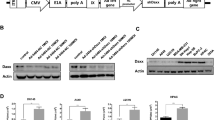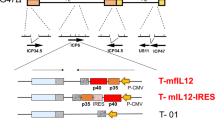Abstract
Herpes simplex virus thymidine kinase (HSV-tk)/gancyclovir (GCV) therapy has the ability to inhibit tumor formation in animal models but the results of clinical trials have been disappointing. To improve the performance of tk/GCV therapy, we tried combination therapy designed to enhance its cytotoxic effects by introducing genes that induce apoptosis of the tumor cells through different pathways. We concentrated our efforts on the use of Bim, a BH3-only member of death activators in the Bcl-2 superfamily, because Bim is not involved in the pathways through which HSV-tk/GCV therapy induces apoptosis in malignant glioma cells. Among three alternative splicing variants, BimEL, BimL, and BimS, BimS lacks the binding domain for the dynein light chain LC8, which negatively regulates the proapoptotic function of BimEL and BimL. All four malignant glioma cell lines, U251, A172, T-430, and U373 underwent cell death after transfer of BimS using an adenovirus vector (AVC2). Intriguingly, combination of AVC2-BimS with AVC2-tk markedly increased the sensitivity of U251 cells to GCV both in vitro and in vivo. In contrast, AVC2-BimL did not induce significant cell death. These results indicated that BimS had the ability to improve the efficiency of HSV-tk/GCV therapy in the treatment of malignant glioma and suggested that the targeting of different proapoptotic pathways may be a useful strategy for the development of an effective gene therapy approach to treatment.
This is a preview of subscription content, access via your institution
Access options
Subscribe to this journal
Receive 12 print issues and online access
$259.00 per year
only $21.58 per issue
Buy this article
- Purchase on Springer Link
- Instant access to full article PDF
Prices may be subject to local taxes which are calculated during checkout







Similar content being viewed by others
References
Moolten FL, Wells JM, Heyman RA, Evans RM . Lymphoma regression induced by gancyclovir in mice bearing a herpes thymidine kinase transgene. Hum Gene Ther 1990; 1: 125–134.
Culver KW et al. In vivo gene transfer with retroviral vector-producer cells for treatment of experimental brain tumors. Science 1992; 256: 1550–1552.
Bi WL, Parysek LM, Warnick R, Stambrook PJ . In vitro evidence that metabolic cooperation is responsible for the bystander effect observed with HSV tk retroviral gene therapy. Hum Gene Ther 1993; 4: 725–731.
Ram Z et al. Therapy of malignant brain tumors by intratumoral implantation of retroviral vector-producing cells. Nat Med 1997; 3: 1354–1361.
Rainov NG . A phase III clinical evaluation of herpes simplex virus type 1 thymidine kinase and ganciclovir gene therapy as an adjuvant to surgical resection and radiation in adults with previously untreated glioblastoma multiforme. Hum Gene Ther 2000; 11: 2389–2401.
Kuribara R et al. Two distinct interleukin-3-mediated signal pathways, Ras-NFIL3(E4BP4) and Bcl-xL, regulate the survival of murine pro-B lymphocytes. Mol Cell Biol 1999; 19: 2754–2762.
Packham G et al. Selective regulation of Bcl-XL by a Jak kinase-dependent pathway is bypassed in murine hematopoietic malignancies. Genes Dev 1998; 12: 2475–2487.
Dumon S et al. IL-3 dependent regulation of Bcl-xL gene expression by STAT5 in a bone marrow derived cell line. Oncogene 1999; 18: 4191–4199.
Silva M et al. Erythropoietin can induce the expression of bcl-x(L) through Stat5 in erythropoietin-dependent progenitor cell lines. J Biol Chem 1999; 274: 22 165–22 169.
Socolovsky M et al. Fetal anemia and apoptosis of red cell progenitors in Stat5a-/-5b-/- mice: a direct role for Stat5 in Bcl-X(L) induction. Cell 1999; 98: 181–191.
Shinjyo T et al. Downregulation of Bim, a proapoptotic relative of Bcl-2, is a pivotal step in cytokine-initiated survival signaling in murine hematopoietic progenitors. Mol Cell Biol 2001; 21: 854–864.
Kitada S et al. γ-Radiation induces upregulation of Bax protein and apoptosis in radiosensitive cells in vivo. Oncogene 1996; 12: 187–192.
Toms S et al. Antagonist effect of insulin-like growth factor I on protein kinase inhibitor-mediated apoptosis in human glioblastoma cells in association with bcl-2 and bcl-xL. J Neurosurg 1998; 88: 884–889.
Shu HK et al. The intrinsic radioresistance of glioblastoma-derived cell lines is associated with a failure of p53 to induce p21(BAX) expression. Proc Natl Acad Sci USA 1998; 95: 14 453–14 458.
Craperi D et al. Increased bax expression is associated with cell death induced by ganciclovir in a herpes thymidine kinase gene-expressing glioma cell line. Hum Gene Ther 1999; 10: 679–688.
Tsujimoto Y, Shimizu S . Bcl-2 family: life-or-death switch. FEBS Lett 2000; 466: 6–10.
Dijkers PF et al. Expression of the pro-apoptotic Bcl-2 family member Bim is regulated by the forkhead transcription factor FKHR-L1. Curr Biol 2000; 10:1201–1204.
Whitfield J et al. Dominant-negative c-Jun promotes neuronal survival by reducing BIM expression and inhibiting mitochondrial cytochrome c release. Neuron 2001; 29: 629–643.
Putcha GV et al. Induction of BIM, a proapoptotic BH3-only BCL-2 family member, is critical for neuronal apoptosis. Neuron 2001; 29: 615–628.
O'Connor L et al. Bim: a novel member of the Bcl-2 family that promotes apoptosis. EMBO J 1998; 17: 384–395.
Hsu SY, Lin P, Hsueh AJ . BOD (Bcl-2-related ovarian death gene) is an ovarian BH3 domain-containing proapoptotic Bcl-2 protein capable of dimerization with diverse antiapoptotic Bcl-2 members. Mol Endocrinol 1998; 12: 1432–1440.
King SM et al. Brain cytoplasmic and flagellar outer arm dyneins share a highly conserved Mr 8000 light chain. J Biol Chem 1996; 271: 19 358–19 366.
Jaffrey SR, Snyder SH . PIN: an associated protein inhibitor of neuronal nitric oxide synthase. Science 1996; 274: 774–777.
Puthalakath H et al. The proapoptotic activity of the Bcl-2 family member Bim is regulated by interaction with the dynein motor complex. Mol Cell 1999; 3: 287–296.
Potthoff RF, Roy SN . A generalized multivariate analysis of variance model useful especially for growth curve problems. Biometrika 1964; 51: 313–326.
Vonesh EF, Carter RL . Efficient inference for random-coefficient growth curve models with unbalanced data. Biometrics 1987; 43: 617–628.
Adams JM, Cory S . The Bcl-2 protein family: arbiters of cell survival. Science 1998; 281: 1322–1326.
de la Taille A et al. Apoptotic conversion: evidence for exchange of genetic information between prostate cancer cells mediated by apoptosis. Cancer Res 1999; 59: 5461–5463.
Fadok VA, Henson PM . Apoptosis: getting rid of the bodies. Curr Biol 1998; 8: R693-R695.
Mi J et al. Induced apoptosis supports spread of adenovirus vectors in tumors. Hum Gene Ther 2001; 12: 1343–1352.
Karamitopoulou E, Perentes E, Diamantis I, Maraziotis T . Ki-67 immunoreactivity in human central nervous system tumors: a study with MIB 1 monoclonal antibody on archival material. Acta Neuropathol (Berl) 1994; 87: 47–54.
Brenner M et al. GFAP promoter directs astrocyte-specific expression in transgenic mice. J Neurosci 1994; 14: 1030–1037.
Miura M, Tamura T, Mikoshiba K . Cell-specific expression of the mouse glial fibrillary acidic protein gene: identification of the cis- and trans-acting promoter elements for astrocyte-specific expression. J Neurochem 1990; 55: 1180–1188.
Miura M, Tamura T, Aoyama A, Mikoshiba K . The promoter elements of the mouse myelin basic protein gene function efficiently in NG108-15 neuronal/glial cells. Gene 1989; 75: 31–38.
Miyao Y et al. Selective expression of foreign genes in glioma cells: use of the mouse myelin basic protein gene promoter to direct toxic gene expression. J Neurosci Res 1993; 36: 472–479.
Okada T et al. Efficient directional cloning of recombinant adenovirus vectors using DNA–protein complex. Nucleic Acids Res 1998; 26: 1947–1950.
Okada T et al. AV.TK-mediated killing of subcutaneous tumors in situ results in effective immunization against established secondary intracranial tumor deposits. Gene Ther 2001; 8: 1315–1322.
Leimig T et al. High-efficiency transduction of freshly isolated human tumor cells using adenoviral interleukin-2 vectors. Hum Gene Ther 1996; 7: 1233–1239.
Acknowledgements
This work was supported in part by Grants-in-Aid for Scientific Research from the Ministry of Education, Culture, Sports, Science and Technology of Japan.
Author information
Authors and Affiliations
Rights and permissions
About this article
Cite this article
Yamaguchi, T., Okada, T., Takeuchi, K. et al. Enhancement of thymidine kinase-mediated killing of malignant glioma by BimS, a BH3-only cell death activator. Gene Ther 10, 375–385 (2003). https://doi.org/10.1038/sj.gt.3301897
Received:
Accepted:
Published:
Issue Date:
DOI: https://doi.org/10.1038/sj.gt.3301897
Keywords
This article is cited by
-
A Quinone-Containing Compound Enhances Camptothecin-Induced Apoptosis of Lung Cancer Through Modulating Endogenous ROS and ERK Signaling
Archivum Immunologiae et Therapiae Experimentalis (2017)
-
Insulin-like growth factor 1 attenuates antiestrogen- and antiprogestin-induced apoptosis in ER+ breast cancer cells by MEK1 regulation of the BH3-only pro-apoptotic protein Bim
Breast Cancer Research (2012)
-
Genetic strategies for brain tumor therapy
Cancer Gene Therapy (2006)
-
Structure of the human Bim gene and its transcriptional regulation in Baf-3, interleukin-3-dependent hematopoietic cells
Molecular Biology Reports (2005)



